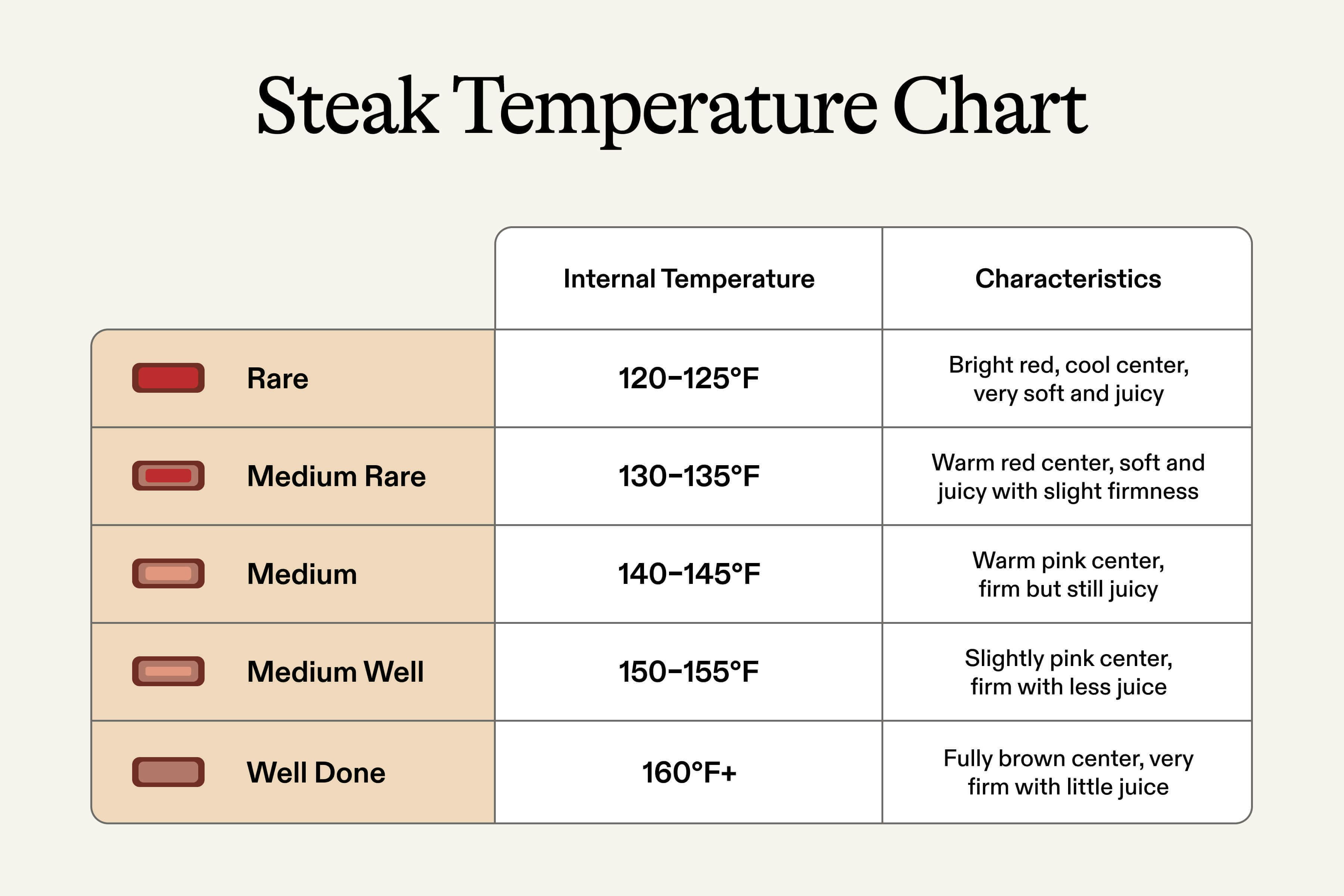Cooking steak just right can feel tricky, especially if you’re new to it. But with a little practice and the right information, you can make steak that’s exactly how you like it — whether that’s pink in the middle or fully cooked through.
This guide will help you understand steak doneness, follow an easy temperature chart, and learn tips to cook it perfectly every time.
Understanding Steak Doneness
Steak doneness describes how cooked the inside of the steak is. The level of doneness affects the flavor, color, and texture of the meat. Some people prefer a juicy, red center, while others like steak that is browned all the way through.
Rare: 120-125 °F
A rare steak has a bright red, cool center that is very soft and juicy. Since it’s cooked only briefly, the meat retains much of its natural flavor and moisture. This level of doneness is best for those who enjoy a very tender texture and a more “raw” taste.
Medium-Rare: 130-135 °F
Medium-rare steak offers a warm red center with a soft, juicy bite and just a bit of firmness. It’s often considered the “chef’s choice” because it balances tenderness with flavor development from searing. People who want the best mix of juiciness and rich beefy taste usually choose this doneness.
Medium: 140-145 °F
Medium steak has a warm pink center and feels firmer while still holding some juiciness. The extra cooking time creates a slightly drier texture but develops a stronger roasted flavor. This is a common choice for those who like a balance between tenderness and a well-cooked bite.
Medium-Well: 150-155 °F
A medium-well steaks have only a slight hint of pink in the center and are much firmer with less juice. The longer cooking time removes most of the moisture, which results in a chewier texture and a more robust, roasted flavor.
Well-Done: 160 °F+
A well-done steak is fully browned all the way through, very firm, and has little to no juice left. Cooking to this level drives off almost all moisture, which can make the steak tougher but ensures no trace of rawness. It’s typically preferred by those who want a thoroughly cooked piece of meat.
Steak Temperature Chart
Use this chart to match your steak’s thickness with your preferred doneness. The cooking times listed are the total time for pan-searing on medium-high heat — you’ll flip the steak once, about halfway through.
For example, if the chart says 4–5 minutes, cook the first side for about 2–2½ minutes, then flip and cook the second side for another 2–2½ minutes.
Keep in mind that thicker steaks usually need a sear on the stovetop followed by finishing in the oven. A meat thermometer is the most reliable way to confirm doneness.
| Steak Thickness | Doneness & Internal Temp | Cooking Time |
| 1/2" | Rare - 120–125°F Medium Rare - 130–135°F Medium - 140–145°F Medium Well - 150–155°F Well Done - 160°F+ | 1–2 min 2–3 min 3–4 min 4–5 min 5–6 min |
| 3/4" | Rare - 120–125°F Medium Rare - 130–135°F Medium - 140–145°F Medium Well - 150–155°F Well Done - 160°F+ | 2–3 min 3–4 min 4–5 min 5–6 min 6–7 min |
| 1" | Rare - 120–125°F Medium Rare - 130–135°F Medium - 140–145°F Medium Well - 150–155°F Well Done - 160°F+ | 3–4 min 4–5 min 5–6 min 6–7 min 7–8 min |
| 1 ¼" | Rare - 120–125°F Medium Rare - 130–135°F Medium - 140–145°F Medium Well - 150–155°F Well Done - 160°F+ | 4–5 min 5–6 min 6–7 min 7–8 min 8–9 min |
| 1 ½" | Rare - 120–125°F Medium Rare - 130–135°F Medium - 140–145°F Medium Well - 150–155°F Well Done - 160°F+ | 5–6 min 6–7 min 7–8 min 8–9 min 9–10 min |
| 2" | Rare - 120–125°F Medium Rare - 130–135°F Medium - 140–145°F Medium Well - 150–155°F Well Done - 160°F+ | 6–7 min 7–8 min 8–9 min 9–10 min 10–11 min |
| 2 ½" | Rare - 120–125°F Medium Rare - 130–135°F Medium - 140–145°F Medium Well - 150–155°F Well Done - 160°F+ | 7–8 min 8–9 min 9–10 min 10–11 min 11–12 min |
Download our steak temp chart infographic to your phone for easy access anytime you need it.





